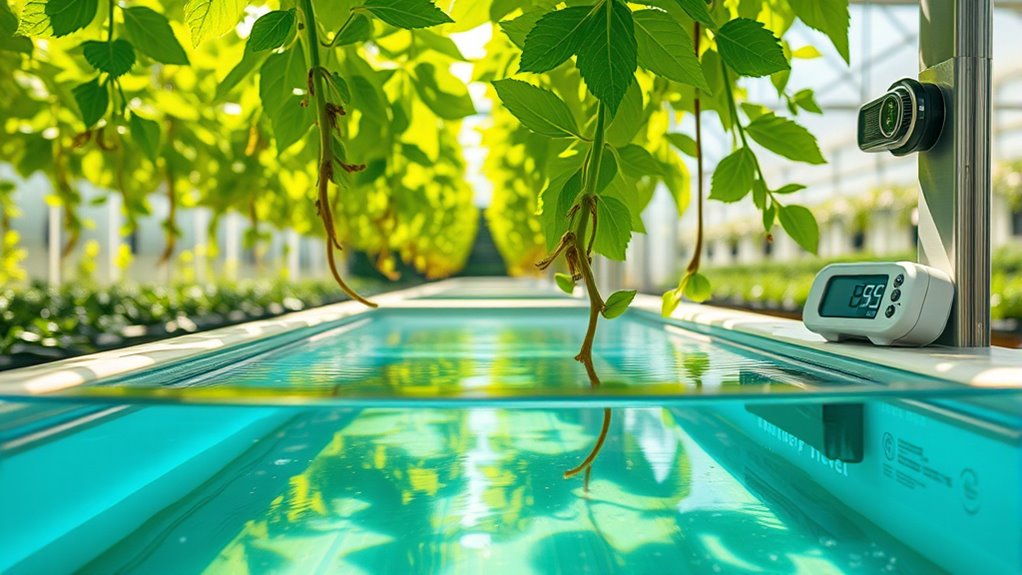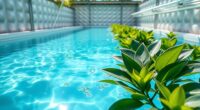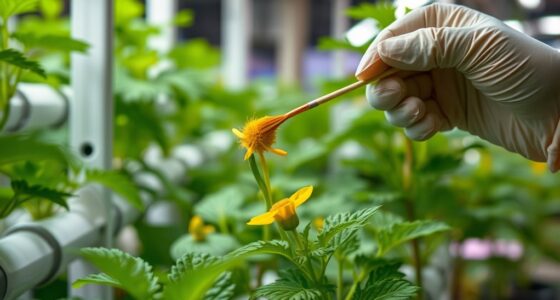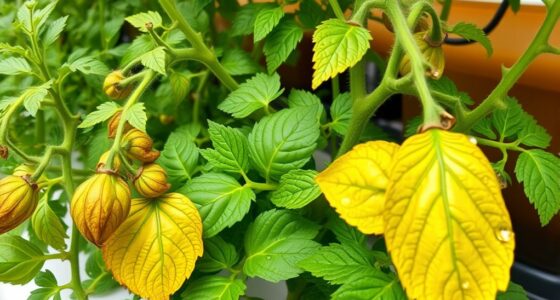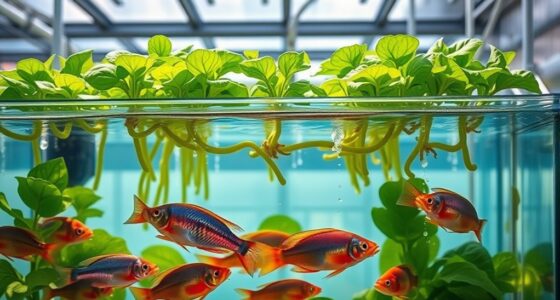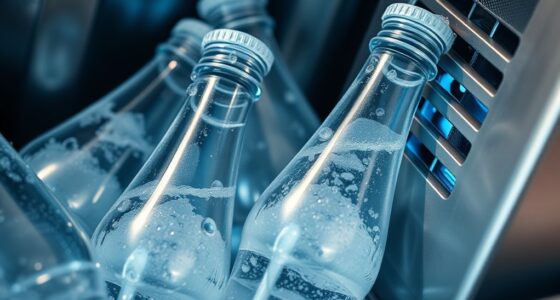To maintain ideal reservoir temperatures during summer, keep the water between 65°F and 75°F by shading your system with shade cloths or curtains, and use evaporative cooling methods like misting or ice packs. Installing aeration devices such as air stones can help increase dissolved oxygen and keep water temperature in check. Monitoring temperature regularly is key; if you want to learn more about effective strategies, there are simple steps you can take to guarantee healthy growth all season long.
Key Takeaways
- Keep nutrient solution temperatures between 65°F and 75°F using shading, ice packs, or evaporative cooling methods.
- Use aeration devices like air stones to increase dissolved oxygen and reduce heat stress for plant roots.
- Regularly monitor water temperature and pH levels, adjusting pH promptly to prevent nutrient uptake issues.
- Replenish and dilute nutrient solutions more frequently to counteract heat-induced nutrient consumption and instability.
- Employ cooling fans and natural shade to prevent solution overheating and maintain stable, optimal reservoir conditions.
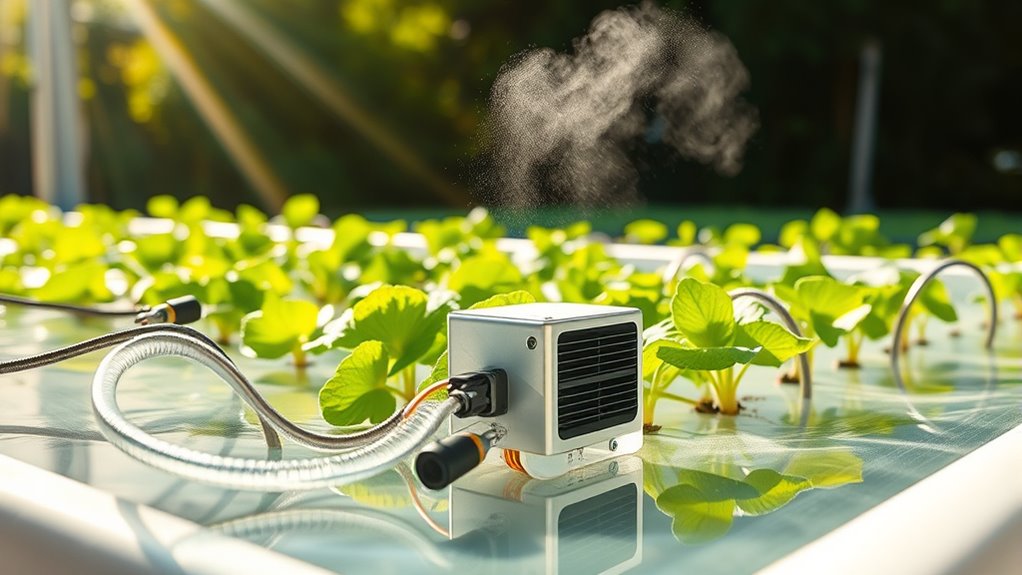
Maintaining the right reservoir temperature is essential for the success of your hydroponic system, as it directly influences nutrient uptake and plant health. During summer, high temperatures can cause the nutrient solution to become warm, which may lead to rapid algae growth, oxygen depletion, and poor plant performance. To keep your system thriving, you need to stay vigilant about temperature control, ensuring the nutrient solution remains within an optimal range—typically between 65°F and 75°F (18°C to 24°C). When temperatures rise, you might notice plants wilting or showing signs of stress, which indicates that the roots aren’t getting enough oxygen or nutrients effectively.
One key aspect of maintaining a healthy hydroponic environment during hot weather is managing the pH level properly. Elevated temperatures can cause fluctuations in pH, making it more difficult for plants to absorb nutrients efficiently. Regular pH level management becomes crucial; you should check your nutrient solution’s pH at least once daily, especially during heatwaves. If you observe pH drifting outside the ideal range of 5.5 to 6.5, make prompt nutrient solution adjustments. This may involve adding pH up or pH down solutions carefully to bring the levels back into balance. Proper pH management ensures your plants can absorb vital nutrients like nitrogen, phosphorus, and potassium without impediments caused by pH imbalance.
In addition to pH level management, nutrient solution adjustments are vital for counteracting the effects of elevated temperatures. Warmer water holds less oxygen, which can stress your plants and hinder nutrient uptake. To mitigate this, consider adding oxygen-rich solutions or using air stones and pumps to increase dissolved oxygen levels. You may also need to adjust your nutrient concentrations, since high temperatures can accelerate nutrient consumption and alter how plants respond to fertilizers. Diluting or replenishing your nutrient solution more frequently helps maintain the right balance. Keep an eye on electrical conductivity (EC) or total dissolved solids (TDS) readings, as these indicate nutrient levels. If they get too high or too low, make necessary adjustments to prevent deficiencies or toxicities.
Furthermore, incorporating Natural Cooling Methods such as shading or evaporative cooling can help maintain stable water temperatures and reduce the need for chemical interventions. Cooling methods such as using ice packs, shading your reservoir, or employing cooling fans can help keep water temperatures in check. These measures prevent the solution from overheating, which not only stabilizes pH and nutrient levels but also promotes healthier root systems. It’s crucial to stay proactive, regularly monitoring both temperature and solution chemistry. By managing pH levels diligently and making precise nutrient solution adjustments, you ensure your plants continue to thrive despite the summer heat. This approach helps maintain optimal growth conditions, strengthens your plants, and maximizes your hydroponic system’s productivity throughout the season.
Frequently Asked Questions
How Often Should I Check Reservoir Temperatures During Peak Summer?
You should check your reservoir temperatures at least twice daily during peak summer to prevent overheating. Regularly calibrate your sensors to guarantee accurate readings, and use insulation techniques to minimize temperature fluctuations. Keep an eye on the readings, especially during heatwaves, and adjust your cooling methods as needed. Consistent monitoring helps maintain ideal conditions for your plants’ growth and health in hot weather.
Can Temperature Fluctuations Harm My Hydroponic Plants?
Temperature fluctuations can harm your hydroponic plants by causing thermal shock, which stresses them and hampers growth. Sudden changes may also lead to nutrient lockout, preventing plants from absorbing essential nutrients. To protect your plants, you should monitor reservoir temperatures regularly and keep them stable. Consistent temperature control minimizes the risk of these issues, ensuring your plants stay healthy and thrive during hot summer months.
What Are the Signs of Temperature Stress in Hydroponic Systems?
You’ll notice temperature stress in your hydroponic system through signs like plant wilting and nutrient imbalance. When temperatures are too high, plants struggle to absorb nutrients properly, leading to yellowing or stunted growth. Conversely, low temperatures can slow growth and cause root issues. Keep an eye out for these symptoms, as addressing temperature fluctuations quickly helps prevent long-term damage and keeps your plants healthy and thriving.
Are There Any Specific Tools for Monitoring Reservoir Temperature Accurately?
Did you know that over 80% of hydroponic growers rely on accurate temperature sensors? To monitor reservoir temperature precisely, you should use reliable temperature sensors that are regularly calibrated. These tools provide real-time data, helping you prevent temperature stress. Proper sensor calibration ensures your readings stay accurate, so you can maintain ideal conditions and keep your plants healthy, especially during hot summer months.
How Do Outdoor Conditions Influence Reservoir Temperature Control?
Outdoor conditions greatly influence reservoir temperature control. You should consider outdoor shade to reduce direct sunlight, which can heat the water excessively. Wind effects also play a role; strong winds can cool or warm your reservoir unevenly. By managing shade and shielding your setup from harsh winds, you help maintain consistent temperatures, preventing temperature swings that could harm your plants. Monitoring regularly guarantees you can adjust your strategies as outdoor conditions change.
Conclusion
Keeping your reservoir at the right temperature is like tending a delicate garden — it’s crucial for thriving plants. During summer, don’t let the heat sabotage your hydroponic success. By monitoring and cooling your reservoir, you’re not just maintaining water; you’re nurturing growth, vitality, and bountiful harvests. Remember, a reservoir’s temperature is the heartbeat of your system—keep it steady, keep your garden alive and flourishing. After all, a cool head and cool water lead to warm harvests.

